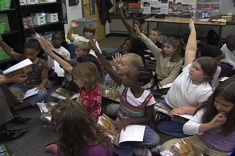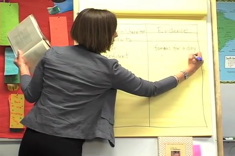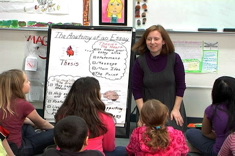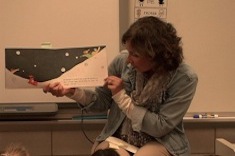Recently I watched a very engaging lesson. The teacher started the lesson by reading aloud a short story about a trip to the beach. Then she projected some photos on the screen with a document camera and told her students all about her family's vacation to Myrtle Beach, South Carolina. The teacher was a wonderful storyteller and jotted down some phrases as she spoke. The students loved their teacher's story and asked lots of questions about her vacation and her family. Some of the students told their own stories about going to the beach. The teacher returned to the original short story and reread some passages in which the author "showed" rather than "told." She then revisited some of the phrases she had used while telling about her trip to the beach, demonstrating how the phrases "showed" rather than "told."
The teacher asked for volunteers to provide a paper for the class to work on together. A boy volunteered his writing folder. The teacher scanned the contents of the folder, found writing appropriate for the lesson, and read it aloud. The students made some suggestions for possible changes that would "show" rather than "tell." Then the teacher asked the students to work in pairs. Each student was instructed to select a piece of his or her current writing and read it to his or her partner, and then both of them were told to suggest changes that would "show, not tell." The students got right to work, and there was a buzz of activity. The teacher called the students back together when most pairs appeared to be finished and asked for some volunteers to share their suggestions for changes to their writing. Throughout the whole lesson, the students were attentive and involved.
There was really only one problem with the lesson. It was supposed to be a minilesson. This minilesson lasted for 35 minutes. Only ten minutes remained in the workshop period for writing and conferring. I was hoping that the teacher would steal time from another discipline and let the students continue writing. But ten minutes later, the students put away their writing folders, grabbed their learning logs, and scurried off to the science lab. Unfortunately, this kind of minilesson was fairly typical in this school. The school had recently adopted a workshop model for instruction. Teachers were struggling to keep their minilessons down to the recommended time allotment.
Exactly how long is too long for a minilesson? I heard Kathy Collins, author of Growing Readers, speak at a conference. She suggested that teachers use the children's ages to determine the appropriate length for a minilesson. Using her guide, a minilesson for this class of fifth graders should have lasted just ten minutes, which would have required shortening the actual lesson by more than 70%! How could the teacher have accomplished this? Let's go through it point by point.
Minimize the Read Aloud
A common technique for teaching minilessons is to read aloud from a mentor text. This teacher selected an excellent book to demonstrate "show, don't tell." However, five to seven minutes could have been shaved off of her 35-minute lesson by reading aloud only those passages that demonstrated "show, don't tell." You don't want to deprive students of hearing such a wonderful story, but a regularly scheduled read-aloud time is the appropriate setting for a read aloud of the entire story. I believe that students benefit from hearing text that we plan to use for teaching points at least twice before the lesson. As a matter of fact, the best books to use for making teaching points are those well-loved books that students have heard, read, and reread numerous times. I know that there are lists of suggested books for teaching specific reading concepts, and there are even entire books devoted to such lists, complete with lesson plans. But you don't have to rely on those lists. Your lessons will usually be more effective if you keep your eyes open for potential teaching points in the books that you use for read aloud, shared reading, literature discussion, and author studies. Depending on the length of the book, this can also help you drastically cut the length of a minilesson by enabling you to read only selected passages.
Be Explicit and Direct
The lesson was well underway before I realized the teacher's goal for the lesson. I loved the short story. I enjoyed looking at the pictures from the beach trip. I enjoyed the teacher's story about her trip to the beach. After about ten minutes, she finally said, "show, don't tell." Why not start off by stating, "Today we are going to work on 'show, not tell'"? Share examples from published books. Share examples from other students' writing. Take a sentence that "tells" (e.g., "The boy got caught in the rain.") and change it into a "showing sentence" together. Remind the students to "show, don't tell" and send them off to write. A minilesson must be explicit, direct, and focused on one teaching point in order to stay within the recommended time allotment.
Keep Your Eye on the Floodgates
Watch out for those openings like, "Have you ever . . ." If you use that phrase, be ready for the flood. Hands shot up when the teacher uttered the words, "Have you ever been to the beach?" These children lived in a city located on the shore of a large lake, and they all had been to the beach. They were bouncing in their seats, eager to talk about their favorite experiences that the teacher's question had brought to the forefront of their recollections. It was not as if she had said, "Have you ever been to the mountains?" The teacher was able to wrestle back the floor long enough to enchant them with her wonderful story. But the kids didn't forget their own stories. They were itching to tell them. After all, the teacher got to tell her story, complete with photographs. When would they get their turn? The teacher finally allowed three children to tell brief snippets of their beach experiences. These children's beach stories added five minutes to the length of the lesson without doing anything to help accomplish the goal of understanding how to "show, don't tell."
Be Prepared
Since the teacher wanted to use a sample of student writing, it would have saved some time if she had chosen this sample before the lesson. It took time to select a volunteer and look through his writing folder to find a good writing sample for the class to work on. Have all the materials that you will need for a minilesson prepared and at your fingertips so that you will not have to use any precious time rounding up teaching materials.
Plan a Series of Minilessons
I could tell that the teacher was very invested in this lesson. It was clear that she put time and effort into its planning. She located the perfect book to demonstrate "show, don't tell." She collected pictures of her trip to the beach. To describe some of the episodes of her trip, she authored some sentences and phrases that "showed." If you find that you absolutely must do everything that you've planned, and it is going to take 35 minutes, do it in a series of lessons. There were three models of show, don't tell: the mentor text, the teacher's story, and the student's story. Present these models over three real minilessons rather than one extra-long, not-so-mini minilesson, and give the students more time to read or write.
Reflection Tools
If you find that you are consistently exceeding recommended time allotments for minilessons, try setting a timer. A timer will be an external reminder that you are on overtime. You might also try taping yourself with a small video camera, watching the lesson, and making decisions about how to conserve time.
The shorter your minilesson, the more time the students will have to read and write.









